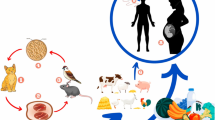Abstract
A total of 70 strongyle-free French Alpine dairy goats were exposed to a combination of sequential and challenge infections with Haemonchus contortus and Trichostrongylus colubriformis third-stage larvae. The sequential infection consisted of three inoculations at 50-day intervals, each infection being abbreviated by anthelmintic treatment at 40 days postinoculation. The challenge infection, composed of the same nematode strains, was undertaken 2 months later, when goats were at their 1st month of lactation. Fecal egg counts (FECs), packed cell volumes (PCVs), pepsinogen concentrations, inorganic phosphate concentrations, and peripheral eosinophil numbers were measured at 30–40 days after each inoculation. Goats were defined as being resistant or susceptible according to their level of nematode egg output following the first inoculation. Significant differences in FECs were recorded between the two groups throughout the further inoculations and the challenge infection. The reliability of FECs was supported by the high repeatability values found within and between infections. With regard to blood constituents, only PCVs related to H. contortus infection showed values that differed significantly between the two groups, resistant goats having higher PCVs after the first and the third inoculations than did susceptible animals. However, this difference was not detectable after the challenge infection. The milk production yield for the current lactation was significantly lower in the resistant goats. Moreover, resistant animals exhibited constantly greater body condition scores as compared with susceptible animals. These results indicate that the individual responsiveness of dairy goats to experimental nematode infection can be estimated on the basis of FECs and PCVs (for H. contortus) and is negatively related to the level of milk production of the animals.
Similar content being viewed by others
Author information
Authors and Affiliations
Additional information
Received: 2 July 1997 / Accepted: 11 September 1997
Rights and permissions
About this article
Cite this article
Chartier, C., Hoste, H. Repeated infections with Haemonchus contortus and Trichostrongylus colubriformis in dairy goats: comparison of resistant and susceptible animals. Parasitol Res 84, 249–253 (1998). https://doi.org/10.1007/s004360050390
Issue Date:
DOI: https://doi.org/10.1007/s004360050390




